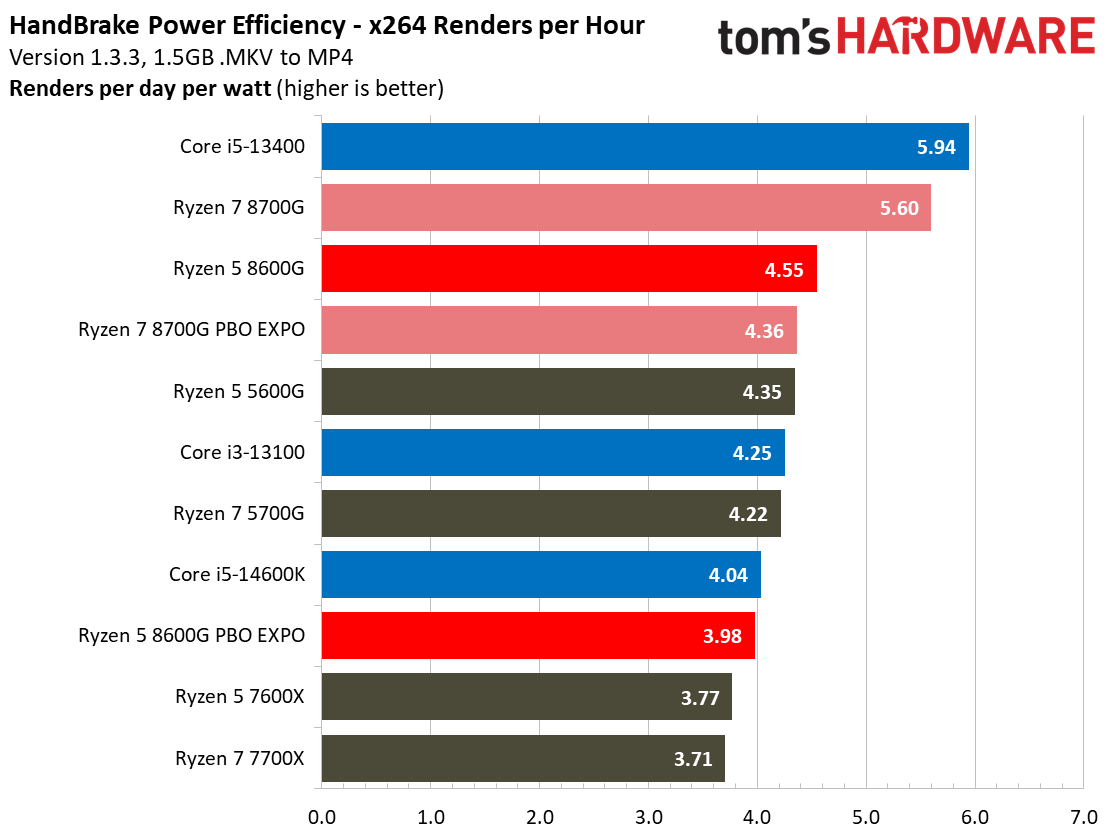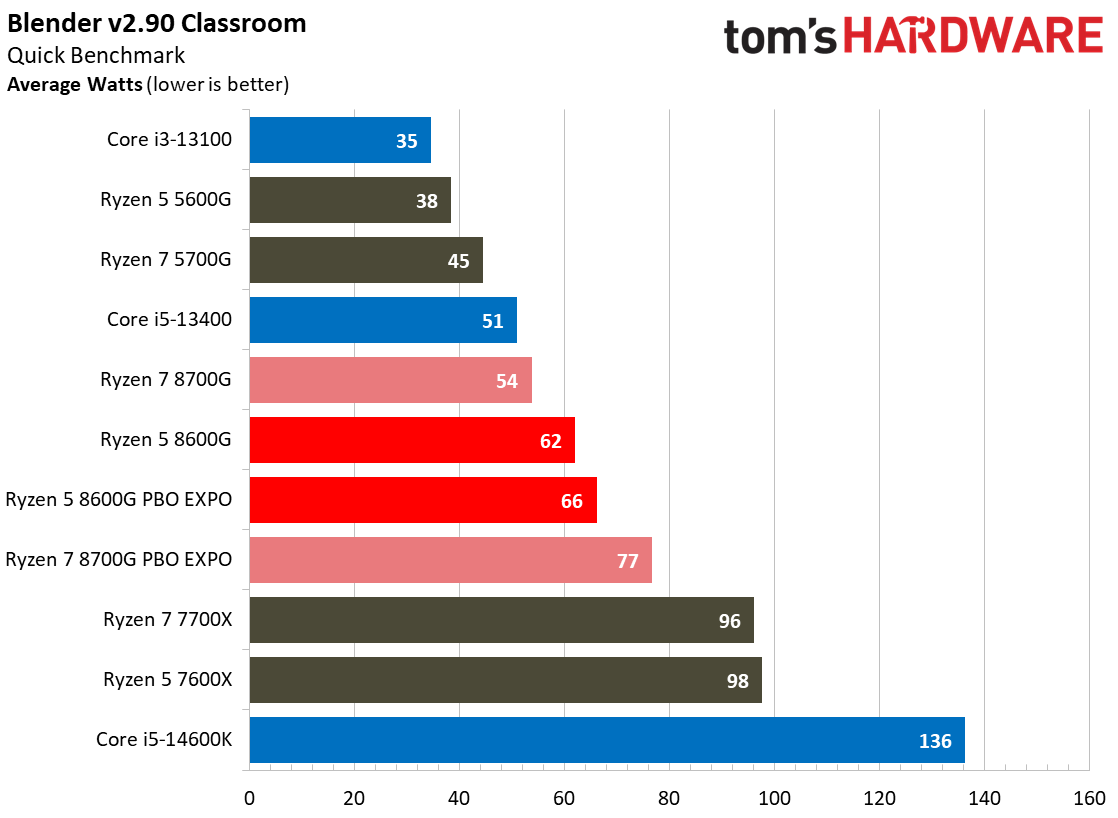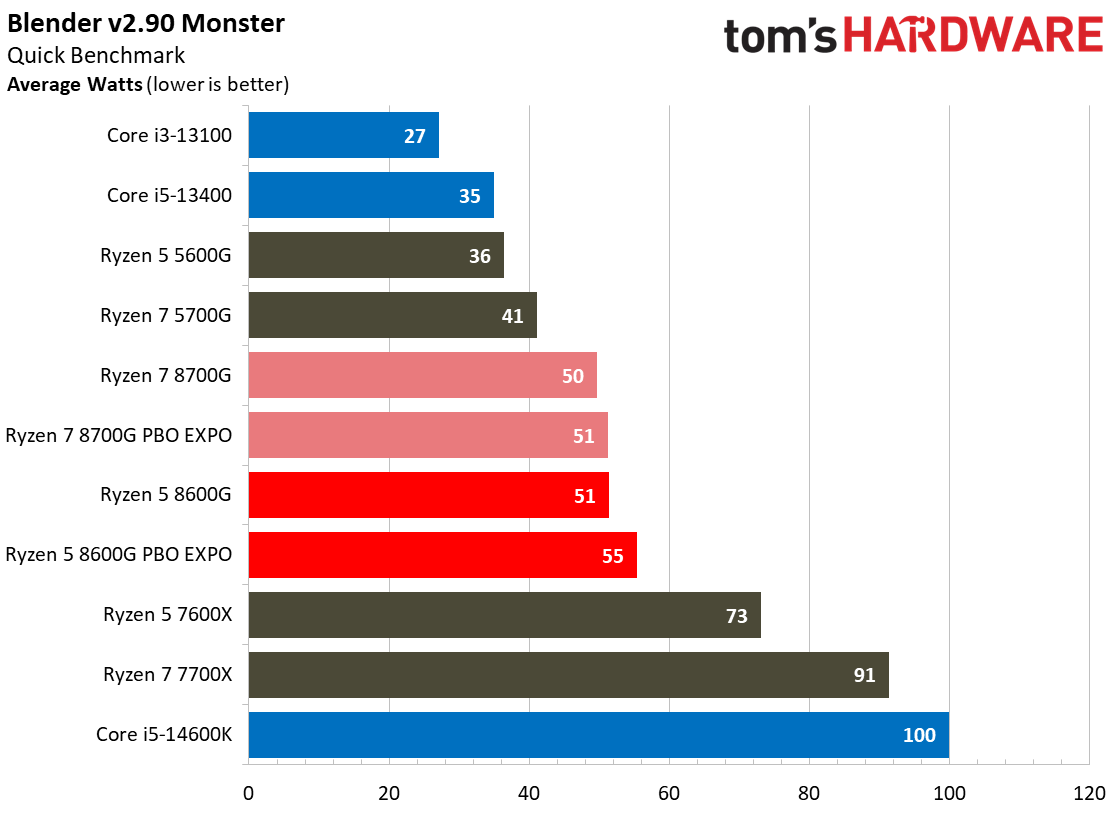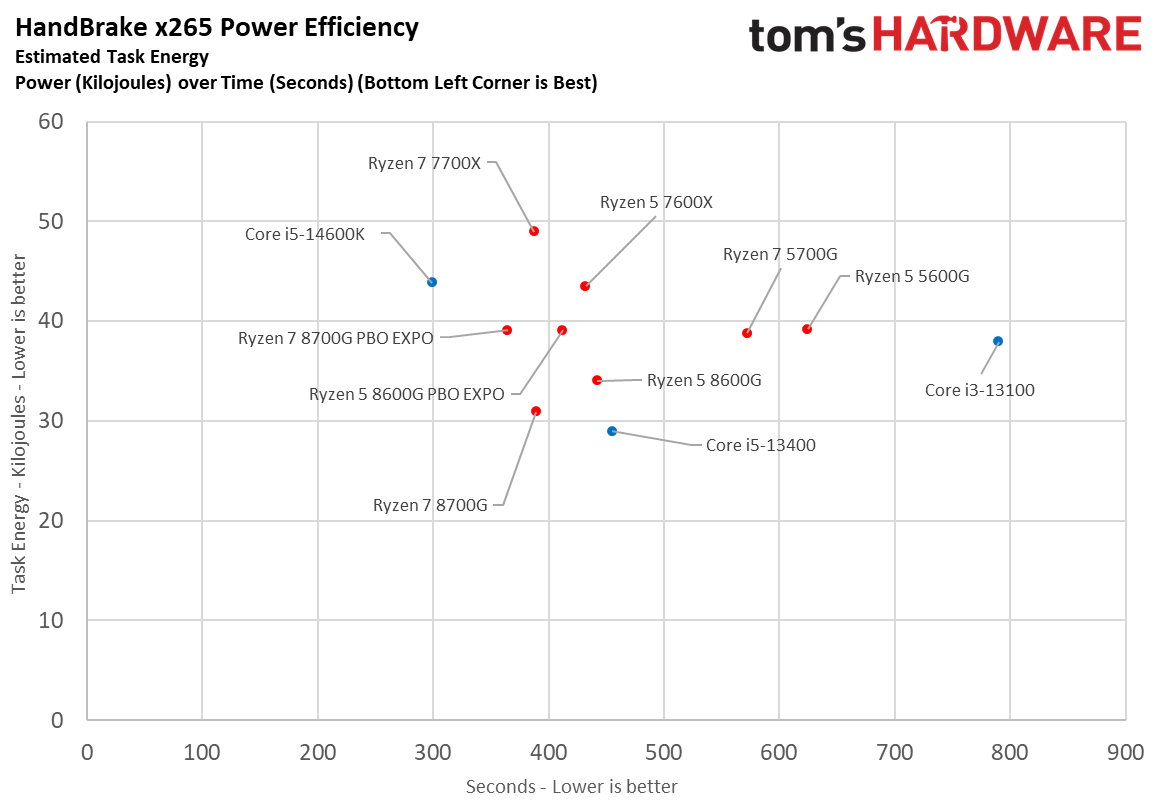Why you can trust Tom's Hardware
AMD Hyper-RX
The Ryzen 5 8600G's RDNA 3 iGPU brings support for new technologies that weren't available with its older 5000G-series models. The 5700G supports the Hyper-RX suite, which includes the in-driver Radeon Super Resolution upscaling tech (built on FSR 1 spatial upscaling), Anti-Lag+, Radeon Boost, and frame generation with AMD Fluid Motion Frames (AFMF). Simply clicking the "Hyper-RX" option in AMD's management software enables all four features.
We tested with all features of Hyper-RX enabled to remain consistent with our prior testing, but you can add or remove features separately. We tested with upscaling from 720p to 1080p with this round of tests, as our previous experiments with upscaling from 990p didn't yield substantial improvements in all titles. We did see noticeable blurriness with fast-moving motion and text in several titles with 720p upscaling, but this is a tunable parameter, so you can adjust as needed. We also encountered occasional odd behavior in some titles and intermittent hiccups in Cyberpunk 2077.
Hyper-RX does require compromising on image quality. However, the amount and intensity of the reduced quality can vary by title — and even by scene. Whether or not the tradeoff is acceptable is largely subjective, so keep that in mind when you view our benchmarks. Our measurement utility doesn't capture the additional frames generated by AFMF — the only way to measure those extra frames is through AMD's driver overlay.
AMD Ryzen 5 8600G Power Consumption and Efficiency









AMD's APUs have always had exceptional power efficiency — the prior-gen 5700G and 5600G are among the most power-efficient chips we've ever tested. Much of this has to do with the process node advantage and monolithic die; AMD's chiplet-based processors not only have one large central die on a less efficient node, but they also have to spend some of their power budget transferring data between the dies. AMD has dominated power efficiency metrics for several chip generations, but Intel's competing processors are closing the gap.
The Ryzen 5 8600G pulls 78W under a full multi-threaded AVX 512 workload in the y-cruncher benchmark, which is a mere 1% less than the Ryzen 7 8700G, which has two more cores. That's still 37% and 61% less than the other eight-core Zen 4 chips, the 7600X and 7700X, respectively. Overall, the 8600G draws a very similar amount of power as the 8700G, but it has two fewer cores, leading to slower performance in our workloads. As such, it falls behind the 8700G in our renders-per-day-per-watt efficiency tests.


The final image takes a slightly different look at power consumption by calculating the cumulative energy required to execute an x264 and x265 HandBrake workload. We plot this 'task energy' value in Kilojoules on the left side of the chart.
These workloads are comprised of a fixed amount of work, so we can plot the task energy against the time required to finish the job (bottom axis), thus generating a really useful power chart. Bear in mind that faster compute times and lower task energy requirements are ideal. That means processors that fall the closest to the bottom left corner of the chart are the best.
Due to its similar power consumption and two additional cores over the Ryzen 5 8600G, the Ryzen 7 8700G again proves to be best in this measure of efficiency, with the 8600G not far behind.
AMD Ryzen 5 8600G Overclocking, and Test Setup
AMD's original BIOS revisions for our Ryzen 7 87000G review had an issue with STAPM (Skin Temperature Aware Power Management) that resulted in lower performance in a subset of heavy multi-threaded workloads. We retested with a newer revision of the BIOS that corrected that issue for this review, and have now updated the results in our original 8700G review. Overall, the impact was minor in gaming — it only impacted F1 2023 when testing with a discrete GPU, which is a niche use case for this chip. We saw a more pronounced impact with multi-threaded workloads with the 8700G, which gained 3.7% more performance in our cumulative metric. In contrast, the 8600G only gained 1.25% more performance. The largest impacts were seen in Cinebench 2024 and extended Blender workloads.
We tested the processors following our usual policy of adhering to the warrantied memory configuration for our stock testing. For AMD, this is DDR5-5200. AMD presents its benchmarks with overclocked DDR5-6400 and also encourages reviewers to test at this speed, but the company does not warranty that level of performance. Officially, AMD deems this to be overclocking, and voltage settings can vary by vendor when you employ the EXPO one-click overclocking profiles.
We used the DDR5-6400 EXPO profile for our memory kit for the configurations marked with "PBO EXPO" in our charts. We also used Precision Boost Overdrive (PBO) with the 'motherboard' power presets for our overclocked configuration. We then enabled a 10X scalar, 200 MHz extra boost for both CPU and GPU, -20 undervolt using the Curve Optimizer for the CPU cores, and a -10 UV for the GPU cores. We applied these settings to both the overclocked 8700G and the 8600G configurations.
Microsoft has advised gamers to disable several security features to boost gaming performance. As such, we disabled secure boot, virtualization support, and fTPM/PTT on all systems for maximum performance. You can find further hardware details in the table below.
| AMD Socket AM5 (B650) | Ryzen 7 8700G, Ryzen 5 8600G |
| Motherboard | ASRock B650 Pro RS |
| RAM | G.Skill Trident Z5 NEO RGB DDR5-6400 - Stock: DDR5-5200 / PBO: DDR5-6400 |
| AMD Socket AM4 | Ryzen 7 5700G, Ryzen 5 5600G |
| Motherboard | ASRock X570 Taichi |
| RAM | 2x 8GB Trident Z Royal DDR4-3600 @ 3200, Kingston DDR4-3200 |
| Intel Socket 1700 DDR5 (Z790) | Core i5-14600K, Core i5-13400, Core i3-13100 |
| Motherboard | Gigabyte Aorus Elite X WiFi7 |
| RAM | G.Skill Trident Z5 RGB DDR5-6800 - Stock: DDR5-5600 |
| AMD Socket AM5 (X670E) | Ryzen 7 7700X, Ryzen 5 7600X |
| Motherboard | ASRock X670E Taichi |
| RAM | G.Skill Trident Z5 Neo DDR5-6000 - Stock: DDR5-5200 |
| All Systems | 2TB Sabrent Rocket 4 Plus, Silverstone ST1100-TI, Open Benchtable, Arctic MX-4 TIM, Windows 11 Pro |
| Gaming GPU | Asus RTX 4090 ROG Strix OC |
| Application GPU | Nvidia GeForce RTX 2080 Ti FE |
| Cooling | Corsair iCue Link H150i RGB |
| Note: | Microsoft advises gamers to disable several security features to boost gaming performance. As such, we disabled secure boot, virtualization support, and fTPM/PTT. |
Get Tom's Hardware's best news and in-depth reviews, straight to your inbox.
Current page: AMD Ryzen 5 8600G Hyper-RX, Power Consumption, Overclocking, Test Setup
Prev Page The Return of the APU Next Page AMD Ryzen 5 8600G iGPU Gaming Benchmarks
Paul Alcorn is the Editor-in-Chief for Tom's Hardware US. He also writes news and reviews on CPUs, storage, and enterprise hardware.
-
Notton Considering how the Core 5 135H is looking, I really wish AMD enabled the full 12CU from this chip.Reply -
usertests APUs are screaming for more memory bandwidth, and the 8600G will look great if it hits the low prices seen for the 5600G along with other platform costs getting cheaper.Reply -
baboma >The current-gen flagship APU, the Ryzen 7 8700G, is 10% faster than the 8600G, but it costs $100 (44%) more, making the 8600G the clear value winner for this generation of APUs.Reply
This is incorrect, because you do not use the APU by itself, but as a part of a system. The correct value calculation is to take the price delta of the entire system but with different APUs.
Assuming a $1K SFF build, the $100 APU price diff would come out to ~10%, which is the same perf diff between 8700G and 8600G. AMD did its pricing homework. The value proposition is the same for both APUs.
I agree both are niche, as their main appeal would be for small SFF (eg NUC), and in that space, mobile parts, eg MTL & AMD 780M parts, may have more functionality and be better value.
>...the 8600G will look great if it hits the low prices seen for the 5600G along with other platform costs getting cheaper.
That'll happen if you're willing to wait ~2 years until the 9600G's release.
5600G pricing was very stable, staying close to its $259 launch price, and only gradually dropping after the 7000 series release on Sep'22.
https://camelcamelcamel.com/product/B092L9GF5N -
jeremyj_83 "Higher DDR5 pricing, no 8GB options"Reply
I am so tired of hearing about DDR5 pricing being a con. While it is more expensive, you won't have a choice for a new CPU in the Zen 5 or 15th Gen anyways. Not to mention due to the added bandwidth the 8600G averages 72% more iGPU performance at 1080p vs the 5600G. If you are looking at doing only iGPU gaming that added cost is minimal compared to extra performance. The lack of an 8GB option is also not a con. Gaming on 8GB is with a dGPU isn't good, unless it is old games. Doing it on an iGPU can kill your performance completely. -
SunMaster I think in most cases the APU will be preferable over the CPU with the old graphics card.Reply
If price is your only reason to go for a system like this, and you badly want to game, the APU isn't the best solution. But case/enclosure size, heat and noise will be the primary reason to choose the APU. The fact that you actually can game on it will what makes the sale. -
Reply
A few years ago I played through the entirety of Star Wars Jedi: Fallen Order on a Ryzen 3200G (no dedicated GPU) and with a 4GB x 2 kit of RAM. The Series S also works fine with what is functionally only 8 GB of RAM shared between the CPU and GPU (there's technically +2 GB for a total of 10, but the extra 2 GB is clocked slow and is for the OS). Memory needs tend to be overstated.jeremyj_83 said:The lack of an 8GB option is also not a con. Gaming on 8GB is with a dGPU isn't good, unless it is old games. Doing it on an iGPU can kill your performance completely. -
jeremyj_83 Reply
Have you tried to do basic work on a computer with Win 10, 8GB RAM, and 2GB RAM reserved for the iGPU? It is painfully slow as you are page swapping all the time. Any computer that isn't a Chromebook should come with less than 16GB RAM now.HopefulToad said:Memory needs tend to be overstated. -
kyzarvs Reply
My desktop is a 32GB ram machine. I also have an i7 / 32gb / 2TB nvme gaming laptop.jeremyj_83 said:Have you tried to do basic work on a computer with Win 10, 8GB RAM, and 2GB RAM reserved for the iGPU? It is painfully slow as you are page swapping all the time. Any computer that isn't a Chromebook should come with less than 16GB RAM now.
When I want portability on the road, I have a dell notebook that's education-oriented. 4GB ram, no fans, small CPU. It runs 10/11 perfectly well, starts up quickly and performs my work requirements (Office / Firefox / NextCloud) pretty much as quick as my main machines. -
mitch074 Erm... Error in the article : Zen3 was using 7nm, not 12 - AMD dropped 12nm with Zen 2 and RDNA.Reply
